
The province of Rimini lies in the southeastern corner of the region of Emilia-Romagna in northern Italy. Most visitors flock to its coast and capital city, Rimini, to enjoy the beaches and ancient old town. From the outskirts of the city of Rimini, the flat landscape gradually rises as the foothills of the Apennines. This hilly region in the province of Rimini is renowned for its picturesque landscapes, blending lush hills and scenic valleys with historic hill towns that offer a glimpse into Emilia-Romagna’s rich cultural heritage. If you’re looking to get away from the coast and explore Rimini’s hinterland for a day or more, I recommend driving around this hilly region and visiting some of the towns. These hill towns of Rimini province are not just beautiful; they are treasure troves of history, art and architecture, totally surrounded by nature.
 A view across the Marecchia Valley to Veruchio
A view across the Marecchia Valley to Veruchio

The hills of the province of Rimini are a beautiful patchwork of vineyards, orchards and forests, punctuated by villages, castles and fortresses. Further inland, the gentle slopes soon make way for a forested range of mountains. As you drive around this lovely region, you’ll pass a variety of landscapes and quaint villages. You won’t miss the little country of San Marino, perched atop a mountain ridge.
 View of San Marino, with its iconic 3 towers
View of San Marino, with its iconic 3 towers
Here’s a guide to some of the most interesting hill towns of Rimini province, each with its unique charm and attractions.
Santarcangelo di Romagna
The closest hill town to the city of Rimini (10km), Santarcangelo di Romagna is a medieval town built on the slopes of Mount Giove. The town’s medieval fortifications can still be seen today, along with secret tunnels and caves inside the mountain. These tufa caves have, for centuries, provided refuge for the town’s citizens during upheavals and storage space for food (particularly cheese) and wine.
 The Triumphal Arch at Ganganelli Square
The Triumphal Arch at Ganganelli Square
From the central Ganganelli Square, walk up the hill to the upper village with its iconic bell tower. Along the way, visit the Musas (the town’s archaeological museum housed in a 17th century palazzo), Grotta di San Michele (tour of the caves), Stamperia Artigiana Marchi (a historic shop that’s famous for its rust-coloured prints) and the cute Button Museum.
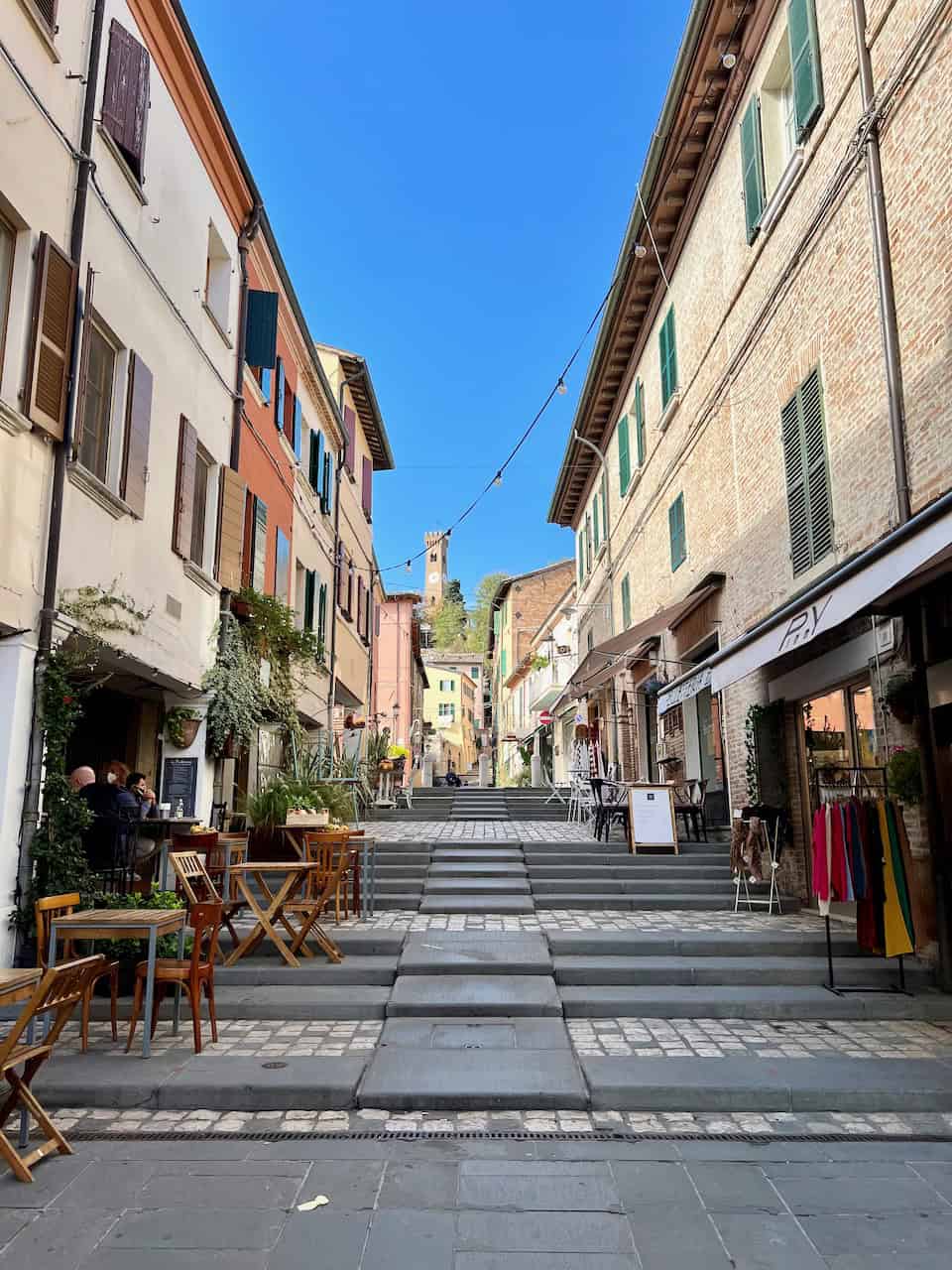 Stroll up the slopes along picturesque streets
Stroll up the slopes along picturesque streets  A quiet street in Santarcangelo di Romagna
A quiet street in Santarcangelo di Romagna  The underground tunnel (tufa) at Lazaroun restaurant
The underground tunnel (tufa) at Lazaroun restaurant
Two restaurants I can recommend for a fantastic meal are: Lazaroun and La Sangiovesa. Ask if you can visit the underground tunnels where they store their unique cheeses and wines.
 The underground tunnels are used to store and mature cheese.
The underground tunnels are used to store and mature cheese.  La Sangiovesa
La Sangiovesa
Santarcangelo di Romagna is a great place to spend a night or two. There’s a good variety of sights, cafés, restaurants and accommodations. I recommend staying at the lovely B&B Villa Ebe.
 B&B Villa Ebe
B&B Villa Ebe
Verucchio
Verucchio, often called the “cradle of the Malatesta family,” is located atop two hills overlooking the lush Marecchia Valley. The 15th century Rocca Malatestiana (Malatesta Fortress) here is one of the best-preserved in the region and offers insights into the medieval life of the Malatesta family.
 Verucchio
Verucchio  Town square
Town square  View from Verucchio towards the Adriatic coast
View from Verucchio towards the Adriatic coast
The town is also rich in Etruscan history as it was the centre of the Villanovan civilisation between 7-9th century BC. The Archaeological Museum is a must-visit, housing Etruscan artifacts and offering a deep dive into the ancient history of the area.
Verucchio also has several beautiful churches like the Collegiate Church of San Martino.
If you’re thinking of spending a night here, do check out the fabulous Oste del Castello Wellness & Bike Hotel in the heart of Verucchio.
At the foot of the hill, in the village of Villa Verucchio, check out Osteria DiVilla Rimini. This restaurant serves amazing food and wines! And don’t leave without a bagful of their home-made cantucci biscuits.
 Seafood pasta at Osteria DiVilla Rimini
Seafood pasta at Osteria DiVilla Rimini
San Leo
San Leo, in the hills of Montefeltro, is a true gem in the province of Rimini. Made famous by Dante Alighieri in the Divine Comedy, San Leo boasts an impressive fortress atop a towering rock.
 Fortress of San Leo
Fortress of San Leo
The centerpiece of the town is the Fortress of San Leo, which has stood since Roman times and was later enhanced by the renowned architect Francesco di Giorgio Martini. The fortress has served as a prison and is famed for holding the enigmatic Count Cagliostro. Visitors can explore the ancient fortress, the Romanesque Cathedral of San Leo, and the 9th century Parish Church of Santa Maria Assunta (one of the oldest churches in the region).
 The fortress seen from the town
The fortress seen from the town  San Leo Cathedral
San Leo Cathedral  Inside the Romanesque Cathedral
Inside the Romanesque Cathedral
Numerous hiking trails traverse the forested hills and offer gorgeous views of the Marecchia Valley. One such trail leads to the 13th century Franciscan Monastery of Sant’Igne.
 Explore the surroundings of San Leo
Explore the surroundings of San Leo
San Leo is a wonderful place to spend a few days in. Search for accommodations in San Leo.
Pennabilli
Pennabilli is an ancient town known for its artistic and spiritual significance. The town, a union of two castles, Penna and Billi, can trace its roots back to Etruscan times. It was the home of the famous poet and screenwriter Tonino Guerra, whose influence is evident in the town’s numerous art installations. Visit the Santuario dei Pensieri (Shrine of Thoughts) to view some of Guerra’s work and enjoy this tranquil garden.
 Pennabilli
Pennabilli  Cathedral of San Leo in the town square
Cathedral of San Leo in the town square  Inside the cathedral
Inside the cathedral
Key attractions include the Cathedral, Mateureka Calculus Museum (yes, that’s right, a calculus museum!), which explores the history of mathematics and computing, and Little Tibet (a spot that the Dalai Lama has visited twice), perched on a hill offering serene views. Nearby, you’ll also find an info board showing the view depicted in one of the paintings by Leonardo da Vinci.
 Little Tibet
Little Tibet  View of the surrounding hills
View of the surrounding hills
The town also hosts the annual Artisti in Piazza (Artists in the Square). This international street art festival transforms the town into an open-air gallery.
Booking.com
Mondaino
Mondaino is a quaint hill town known for its historical reenactments and festivals. Perched on a hilltop overlooking the Conca Valley. The Rocca Malatestiana, a Malatesta fortress, dominates the town, offering stunning views.
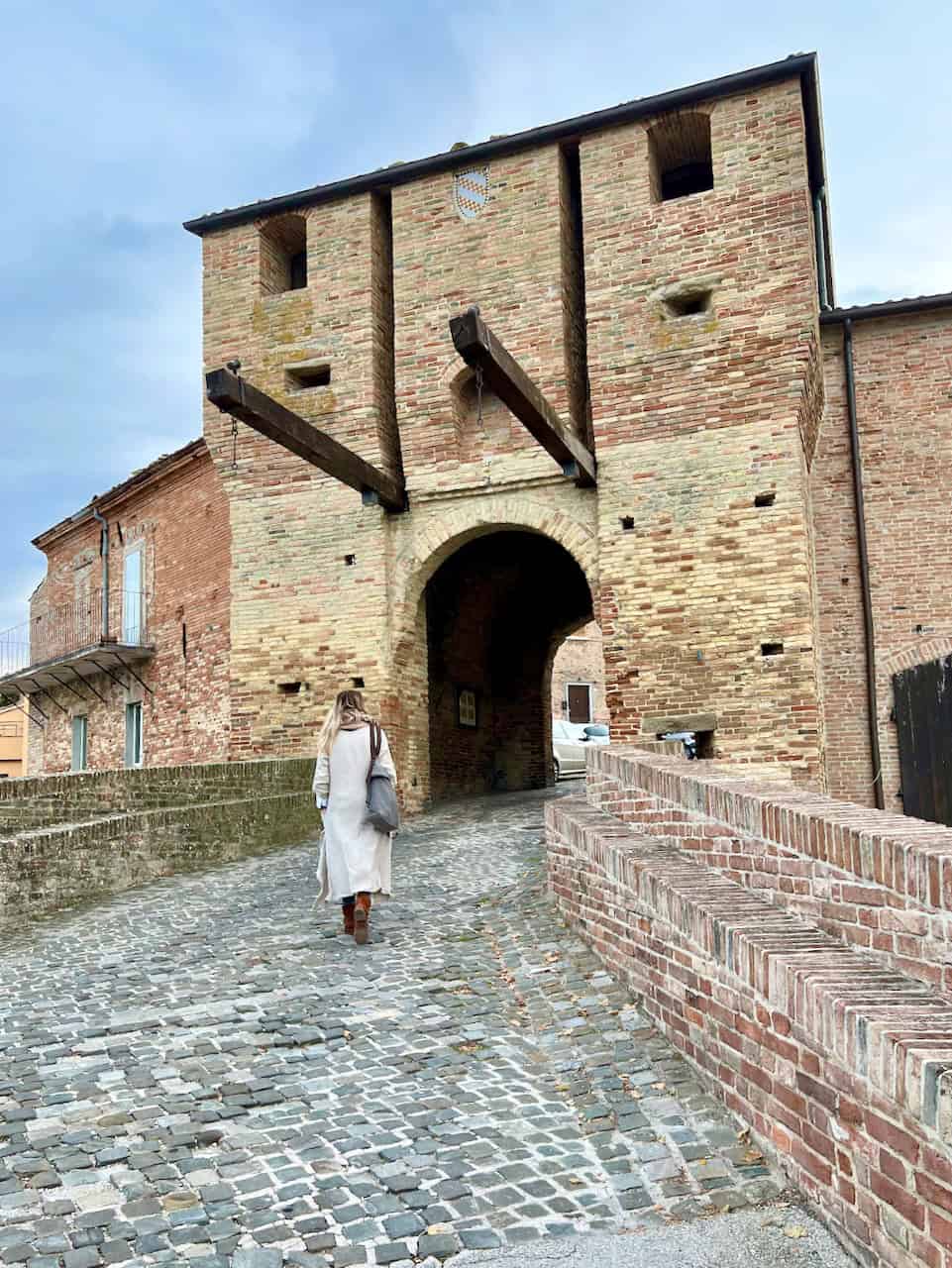 Entrance to Mondaino
Entrance to Mondaino
Start your walk at the Piazza Maggiore, the town’s 19th century market square. The square is a semi-circular shape lined by a neo-Classical arcade. Mondaino is also home to the Museum of Paleontology, which provides a fascinating look into the ancient marine life that once inhabited the area.
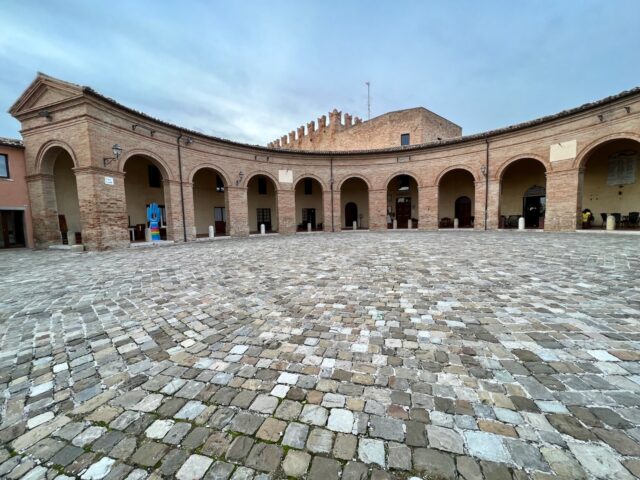 Piazza Maggiore
Piazza Maggiore  A quiet street in Mondaino
A quiet street in Mondaino
In August each year, Mondaino hosts Palio del Daino, a medieval festival that recreates historical events with costumes, games, and performances.
Saludecio
Saludecio is celebrated for its vibrant murals that adorn many of its buildings. Located not far away from Mondaino, in the Conca Valley, Saludecio is built on a ridge, which gives the town its elongated form. The first thing you’ll notice, as you enter the town through the 14th century Porta Marina, are the town’s rustic streets and colourful murals.
 The impressive Porta Marina
The impressive Porta Marina  The murals add a splash of colour to the village
The murals add a splash of colour to the village 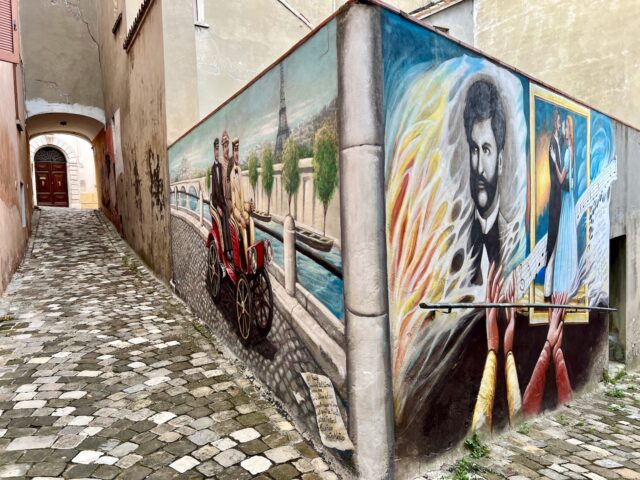 Murals adorn many walls
Murals adorn many walls
The town’s Parish Church of San Biagio is known for its baroque interior and art. The Scent of the 1800’s Festival, held every August, transforms Saludecio into a living museum of the 19th century, with music, food, and crafts.
Near Saludecio, I recommend dining at Ristorante al Chiar di Luna, a rather outlandish restaurant with an incredible wine cellar and stunning food!
 Ristorante al Chiar di Luna
Ristorante al Chiar di Luna  A section of the wine cellar. Diners can enjoy an aperitivo here and choose a bottle of wine.
A section of the wine cellar. Diners can enjoy an aperitivo here and choose a bottle of wine.
Sant’Agata Feltria
Sant’Agata Feltria, one of the most picturesque hill towns in the Rimini province, is famed for its fairy-tale atmosphere and cultural richness.
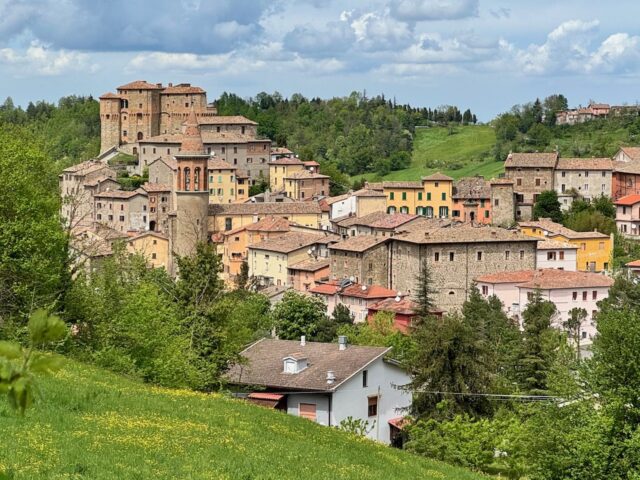 Sant’Agata Feltria
Sant’Agata Feltria
The town’s iconic Rocca Fregoso fortress is a stunning example of medieval architecture. Sitting high on a hill, the fortress offers sweeping views of the surrounding countryside. The town’s charming streets and historic buildings make it perfect for those seeking a blend of history, culture, and natural beauty.
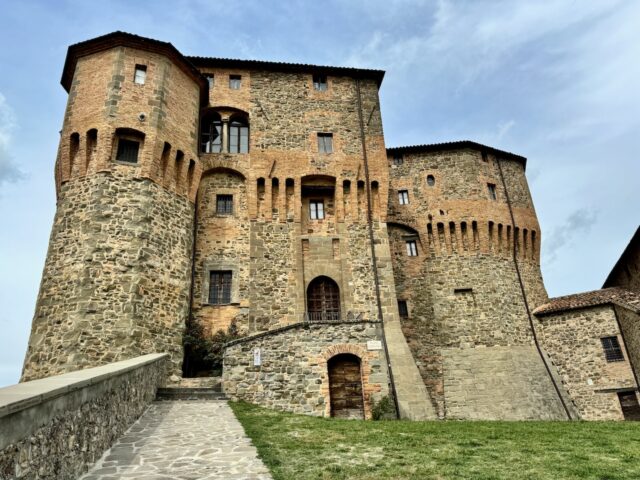 Rocca Fregoso
Rocca Fregoso  Stunning views from the fortress
Stunning views from the fortress  A quaint street in Sant’Agata Feltria
A quaint street in Sant’Agata Feltria
Teatro Angelo Mariani is a fascinating attraction in the town. This is Italy’s oldest wooden theater and provides a unique glimpse into the artistic heritage of the area.
 Teatro Angelo Mariani
Teatro Angelo Mariani
Sant’Agata Feltria is famous for its annual Truffle Fair. Every October, it draws food enthusiasts from across the globe to savour its gourmet offerings.
 Indulge in a truffle dish!
Indulge in a truffle dish!
Search for accommodations in Sant’Agata Feltria.
The hill towns of Rimini province offer more than just scenic beauty; they are rich in history, culture and artistic heritage. From medieval fortresses and ancient churches to vibrant festivals and interesting museums, each town provides a unique window into Emilia-Romagna’s past and present. If you’re touring the region, don’t miss visiting some of these hill towns.
Car hire
Read more about Emilia-Romagna
See my photo essay on reasons I love Italy
Please visit:
Our Sponsor
